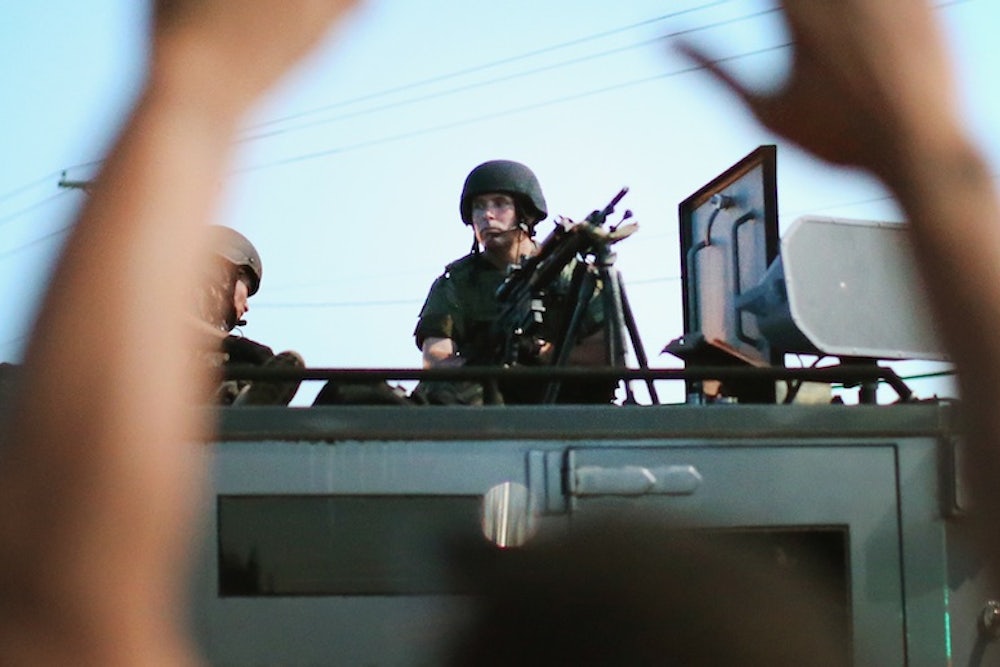First came the police officer’s fatal shooting of an unarmed black teenager on the way back from the convenience store with a friend. Then came the protests and looting. Then came the astonishing police response, which by Wednesday night transformed the streets of Ferguson, Missouri, an inner suburb of St. Louis, into a scene out of Cairo, Kiev, or Tehran. Which has led appalled onlookers to ask: Who has been outfitting local police departments to look like battle-hardened military units?
You have.

Since the Sept. 11 attacks, the American taxpayer has been providing the funding for an eye-popping influx of money from the Department of Homeland Security to state and local law enforcement agencies. The funding is all in the name of preventing “terrorism,” but funds are fungible, and so are heavily-armored vehicles and high-powered weaponry. As the Missouri Department of Homeland Security explains on its own website advertising one of the federal DHS grants it distributes to local agencies: “Activities implemented under [the State Homeland Security Program] must support terrorism preparedness by building or enhancing capabilities that relate to the prevention of, protection from, or response to, and recovery from terrorism in order to be considered eligible. However, many capabilities which support terrorism preparedness simultaneously support preparedness for other hazards.” [Emphasis mine.]
Other hazards—like the disturbances that can spring up in the event of a police shooting of an unarmed 18-year-old named Michael Brown.
To get a sense of just how much money is funneling to police departments like those in St. Louis County, of which Ferguson is a part, I dug into a federal spending database. In the past five years alone, I tallied:
- More than $40 million from the U.S. Department of Homeland Security to the Missouri Office of Homeland Security (which is housed within the Missouri Department of Public Safety) for “state and local programs.”
- Nearly $19 million in “emergency performance management grants” from DHS to the Missouri Department of Public Safety. The most recent of the grants, for $6.59 million, arrived on June 5.
- Nearly $10 million from DHS to the Missouri Office of Homeland Security for the “urban areas security initiative.” Here’s how DHS describes that program: “to enhance regional preparedness and capabilities in 25 high-threat, high-density areas. The 9/11 Act requires states to dedicate 25 percent of UASI funds to law enforcement terrorism prevention activities.” St. Louis is one of those 25 “high-threat, high-density areas.” And even if the 25 percent is dedicated to true terrorism-related threats, the 75 percent left over from that leaves a lot to work with.
As the New York Times has reported, state and local law enforcement agencies are getting armored up from another source as well: the U.S. military. With our troops withdrawals from Iraq and Afghanistan, “the former tools of combat—M-16 rifles, grenade launchers, silencers and more—are ending up in local police departments, often with little public notice. During the Obama administration, according to Pentagon data, police departments have received tens of thousands of machine guns; nearly 200,000 ammunition magazines; thousands of pieces of camouflage and night-vision equipment; and hundreds of silencers, armored cars and aircraft.” USA Today reported Wednesday night that Ferguson is among the countless towns that received some of the nearly $450 million in military surplus distributed in 2013—most recently, two unidentified vehicles, a trailer, and a generator last November.
But what’s really driving the spectacle of militarized local police is that spigot of money that was turned on after Sept. 11, 2001, when a federal government abashed to have missed so many warning signs for those devastating attacks acted as if that massive failure could be washed away by sparing not a cent in preventing the next one. A whole industry has sprung up to capitalize on that spigot—like the company that’s been selling mine-resistant BearCats at $280,000 a pop to 100 towns per year. The flow of funds has become so reliable that the Missouri Office of Homeland Security holds regular workshops to advise local agencies on how to get their hands on the dough; the most recent one was held on July 24, at the Meramec Regional Planning Commission in St. James, according to a notice published in the Rolla Daily News.
So we have had the absurd spectacles of $100 million in counter-terrorism funds going to South Dakota (pop. 833,000), a BearCat patrolling a pumpkin festival in New Hampshire, and $90,000 spent on bollards and surveillance at the Seattle Mariners and San Diego Padres’ spring-training facility. And now we have protesters in a St. Louis suburb being confronted with exo-skeletal defenders of the peace who look like they arrived straight from the Maidan or Tahrir Square. Consider it one more consequence of that awful day nearly 13 years ago, and the mindset of fear, vengeance, and unreason that it provoked. Yes, it was a certain administration that launched two wars and created a Department of Homeland Security in response to that day, but it is hardly alone in the responsibility. We’ve been bankrolling this bulk-up ever since, with nary a word crosswise, and now the results are rolling through our streets. After all, if you’ve got it, why not use it?
